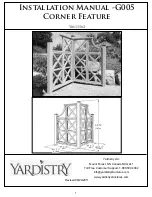
Troubleshooting the Oscilloscope
The service policy for this instrument is replacement of defective
assemblies. The following procedures can help isolate problems to the
defective assembly.
W A R N I N G
SHOCK HAZARD!
The maintenance described in this section is performed with power supplied
to the oscilloscope and with the protective covers removed. Only trained
service personnel who are aware of the hazards involved should perform the
maintenance. Whenever possible, perform the procedures with the power
cord removed from the oscilloscope. Read the safety summary at the front
of this book before proceeding. Failure to observe safety precautions may
result in electrical shock.
C A U T I O N
Do not disconnect any cables or remove any assemblies with the power
applied to the oscilloscope, or damage to the oscilloscope can occur.
C A U T I O N
ELECTROSTATIC DISCHARGE (ESD) can damage electronic components.
When using any of the procedures in this chapter you should use proper ESD
precautions. As a minimum, you should place the instrument on a properly
grounded ESD mat and wear a properly grounded ESD strap.
The following equipment is needed for troubleshooting the oscilloscope.
Table 4-18
Equipment Required
Equipment
Critical specifications
Recommended
model/part
Digital multimeter
Accuracy
±
0.05%, 1 mV resolution
HP 34401A
Oscilloscope
100 MHz
HP 54600B
Probe
10:1 division ratio
HP 10432A
Dummy load
1
Compatible with power supply
see note 1 below
1
See page 4–41 to construct your own dummy load.
4–40
Summary of Contents for HP 54600B
Page 7: ...vi ...
Page 12: ...1 The Oscilloscope at a Glance ...
Page 28: ...2 Operating Your Oscilloscope ...
Page 69: ...2 42 ...
Page 70: ...3 Using Option 005 Enhanced TV Video Trigger HP 54602B ...
Page 148: ...Exploded view of oscilloscope Figure 4 11 Service Replacing Parts in the Oscilloscope 4 59 ...
Page 153: ...4 64 ...
Page 154: ...5 Performance Characteristics ...
Page 175: ...Glossary 8 ...
















































